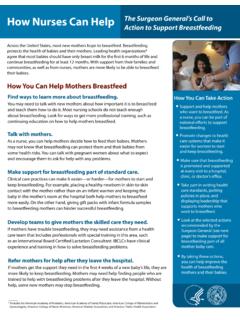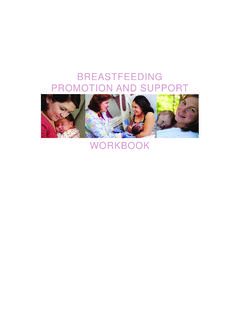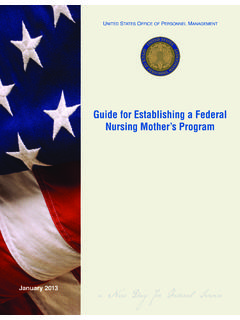Transcription of BREASTFEEDING 21 ST - who.int
1 BREASTFEEDING IN THE 21ST CENTURY1In every country of the world, BREASTFEEDING has a multitude of benefits for women and children: saving lives, improving child health and protecting mothers against ovarian and breast cancer deaths. While mothers have been BREASTFEEDING for centuries, we have only recently begun to fully understand its vital role in health and development. With the release of new research in The Lancet, the evidence is now stronger than ever, demonstrating the substantial benefits of BREASTFEEDING for children and women in high- and low-income countries alike. Yet despite this growing body of evidence, global rates of BREASTFEEDING have not substantially increased in the past two decades. Exclusive BREASTFEEDING rates among children under 6 months are well below 50 percent in most countries the current World Health Assembly 2025 target. Most countries rich and poor alike are off track to meet the global target.
2 In the poorest countries, late initiation and low rates of exclusive BREASTFEEDING are the main challenges, as less than 40 percent of children under 6 months are exclusively breastfed. Short overall duration of BREASTFEEDING presents an additional challenge, particularly in middle- and high-income countries, where less than one in five children are breastfed for the first 12 months. Additionally, most high-income countries have uneven or limited BREASTFEEDING data, which makes it difficult to track progress and trends. BREASTFEEDING is one of the few positive health behaviors that is more prevalent in poor than in rich countries; in addition, poor women breastfeed for longer than rich women in low- and middle-income countries (LMICs). These results suggest that BREASTFEEDING patterns are currently contributing to reducing the health gaps between rich and poor children in LMICs, which would be even greater in the absence of BREASTFEEDING .
3 In contrast, the social patterning of BREASTFEEDING in rich countries is in the opposite direction, with higher rates among wealthier and more educated women.> BREASTFEEDING has substantial benefits for children and women in high- and low-income countries alike, and the evidence is now stronger than ever.> The health and economic benefits of BREASTFEEDING are huge: increasing BREASTFEEDING rates could save hundreds of thousands of lives and add hundreds of billions of dollars to the global economy each year.> Increasing the rates of BREASTFEEDING worldwide is a fundamental driver in achieving the Sustainable Development Goals by 2030. BREASTFEEDING plays a significant role in improving nutrition, education, and maternal and child health and survival. > Rapid progress is possible, and we know what needs to be done more countries need to invest in the policies and programs that support women s BREASTFEEDING mother and child, no matter their location or circumstance, benefits from optimal BREASTFEEDING IN THE 21ST CENTURY2 Figure 1 shows the proportion of children around 12 months of age who are breastfed in 153 countries.
4 THE BENEFITS OF BREASTFEEDING BREASTFEEDING and child healthExclusively breastfed infants have only 12 percent of the risk of death in LMICs as those who were not breastfed underscoring the strong protective effect of exclusive BREASTFEEDING . On average, infants younger than six months who are not breastfed are 3-4 times more likely to die than those who received any breastmilk. There is overwhelming evidence that BREASTFEEDING protects against the two leading causes of death in children under 5 years pneumonia and diarrhea. Nearly half of all diarrhea episodes and one-third of all respiratory infections would be prevented with BREASTFEEDING . Protection against hospital admissions due to these diseases is even greater 72 percent and 57 percent, provides major protection where infectious diseases are common causes of death, but even in high-income populations it lowers mortality.
5 One meta-analysis showed that BREASTFEEDING was associated with a 36 percent reduction in sudden infant deaths, while another showed a 58 percent decline in necrotizing enterocolitis, the most common and serious intestinal disease among premature babies. BREASTFEEDING also protects against infections in high-income countries, particularly diarrhea, respiratory infections and otitis media (ear infections).Longer BREASTFEEDING duration was associated with a 13 percent reduction in the likelihood of overweight and/or obesity prevalence and a 35 percent reduction in type-2 diabetes incidence. Illustration: 15TL_1885_1 Editor: Katherine GourdAuthor: C esar G. VictoraName of Illustrator: started: 11/11/2015 NFast TrackText typedImage redrawnIllustrator checkProofreader checkY0 Percentage of children who receive any breastmilk at 12 months of age (%)102030405060708090100No data3 BREASTFEEDING and cognitive developmentBreastfeeding helps prepare children for a prosperous future.
6 Across all income levels, BREASTFEEDING is consistently associated with higher performance in intelligence tests among children and adolescents, with a pooled increase of 3 IQ points on average, controlling for maternal IQ. Some studies show that increased intelligence as a result of BREASTFEEDING translates to improved academic performance, increased long-term earnings and productivity. BREASTFEEDING and maternal health There are health benefits for women that breastfeed, including the reduction of risks for both breast and ovarian cancers. Each year a mother breastfeeds, her risk of developing invasive breast cancer is reduced by 6 percent; longer BREASTFEEDING is also associated with a reduction in ovarian cancer. Current rates of BREASTFEEDING prevent almost 20,000 deaths from breast cancer each year, and another 20,000 deaths could be prevented by improving BREASTFEEDING : a critical intervention in reducing under-5 child deaths More than 820,000 lives (87 percent of them infants under 6 months of age) would be saved annually in 75 LMICs with increased BREASTFEEDING .
7 BREASTFEEDING is one of the top interventions for reducing under-5 mortality. To achieve its full impact, BREASTFEEDING should continue up to the age of two years as its protective effect extends well into the second year of life. In children aged 6-23 months, any BREASTFEEDING was associated with a 50 percent reduction in deaths. WHY INVEST, AND WHAT IT WILL TAKE TO IMPROVE BREASTFEEDING PRACTICES?Despite the multitude of benefits, women today do not have the support they need to breastfeed, and face daily barriers in doing so. BREASTFEEDING is influenced by a wide variety of factors, as demonstrated by the following conceptual model (Figure 2) from The Lancet BREASTFEEDING Series. Illustration: 15TL_2177_1 Editor: DM/Katherine GourdAuthor: Nigel RollinsName of Illustrator: started: 16/11/2015 NFast TrackText typedImage redrawnIllustrator checkProofreader checkYStructuralSociocultural and market contextSettingsHealth systemsand servicesFamily andcommunityWorkplace andemploymentIndividualEarlyinitiationEx clusivebreastfeedingContinuedbreastfeedi ngMother andinfant attributesMother infantrelationshipDeterminantsInterventi onsSocial mobilisation andmass media++Legislation, policy, financing,monitoring, and enforcementCounselling, support, andlactation managementFigure 2: Enabling Conditions for BREASTFEEDING : A Conceptual ModelBREASTFEEDING IN THE 21ST CENTURY4 Interventions to improve BREASTFEEDING practices The Series examined the effects of interventions according to the settings identified in the conceptual model.
8 Health systems and services: In the health system, providers influence and support feeding decisions at key moments before and after birth and later when there are challenges to maintaining exclusive and continued BREASTFEEDING . Substantial gaps in knowledge and skills to support BREASTFEEDING are reported at all levels of healthcare staff. The Series meta-analyses considered the effects of a number of interventions included within the Baby Friendly Hospital Initiative (BFHI), such as individual counseling or group education, immediate BREASTFEEDING support at delivery, and lactation management training for health staff, which were found to increase exclusive BREASTFEEDING by 49 percent and any BREASTFEEDING by 66 percent. Family and community: Within families, the practices and experiences of other women affect BREASTFEEDING . In many traditional societies, colostrum is thought to be harmful and may be discarded, while pre-lacteal feeds may delay BREASTFEEDING initiation for several days.
9 Home- and family-based interventions were effective at improving early initiation, as well as exclusive, continued and any BREASTFEEDING . In addition, community-based interventions including group counseling or education and social mobilization were similarly effective, increasing timely BREASTFEEDING initiation by 86 percent and exclusive BREASTFEEDING by 20 percent. Maternity protection and the workplace: Women s work is a leading reason for not BREASTFEEDING or early weaning. The availability of breaks and on-site rooms for BREASTFEEDING and the provision of maternity leave are important given the increasing numbers of women in the workforce. However, too few women have access to adequate maternity entitlements that enable BREASTFEEDING , either because they are not provided or because they are working in the informal economy and therefore not eligible.
10 Although virtually all countries have maternity protection legislation, only 42 (23 percent) meet or exceed the International Labor Organization s (ILO) recommendation of 18 week s paid leave. The Series also found:> Women planning to return to work after childbirth are less likely to initiate or continue BREASTFEEDING . Short maternity leave (less than six weeks) increases the odds of not BREASTFEEDING or stopping early by 400 percent.> Paid breaks guaranteed for at least six months were associated with an percentage point increase in exclusive BREASTFEEDING (results vary by country). > Reducing barriers to BREASTFEEDING for working mothers by providing lactation rooms and nursing breaks is one low-cost intervention that may reduce absenteeism and improve workforce performance, commitment and retention. For example, a study in the reported that lactation rooms and break time to express milk were associated with a 25 percent increase in BREASTFEEDING at six months.














